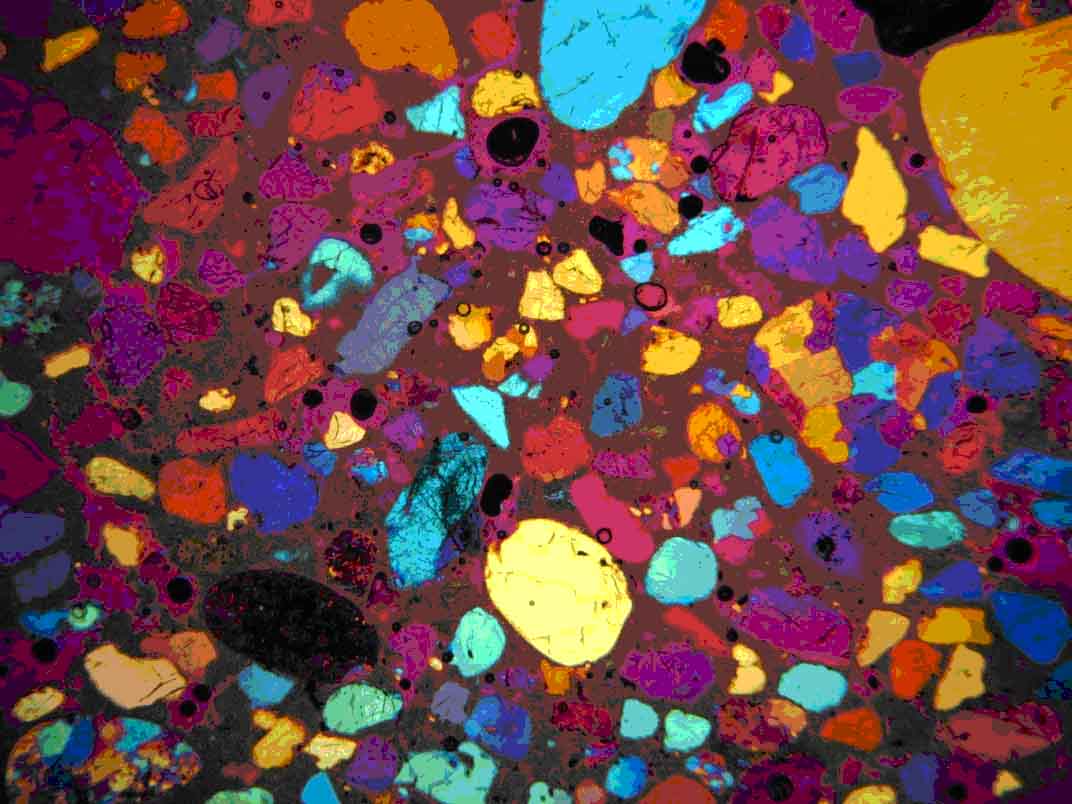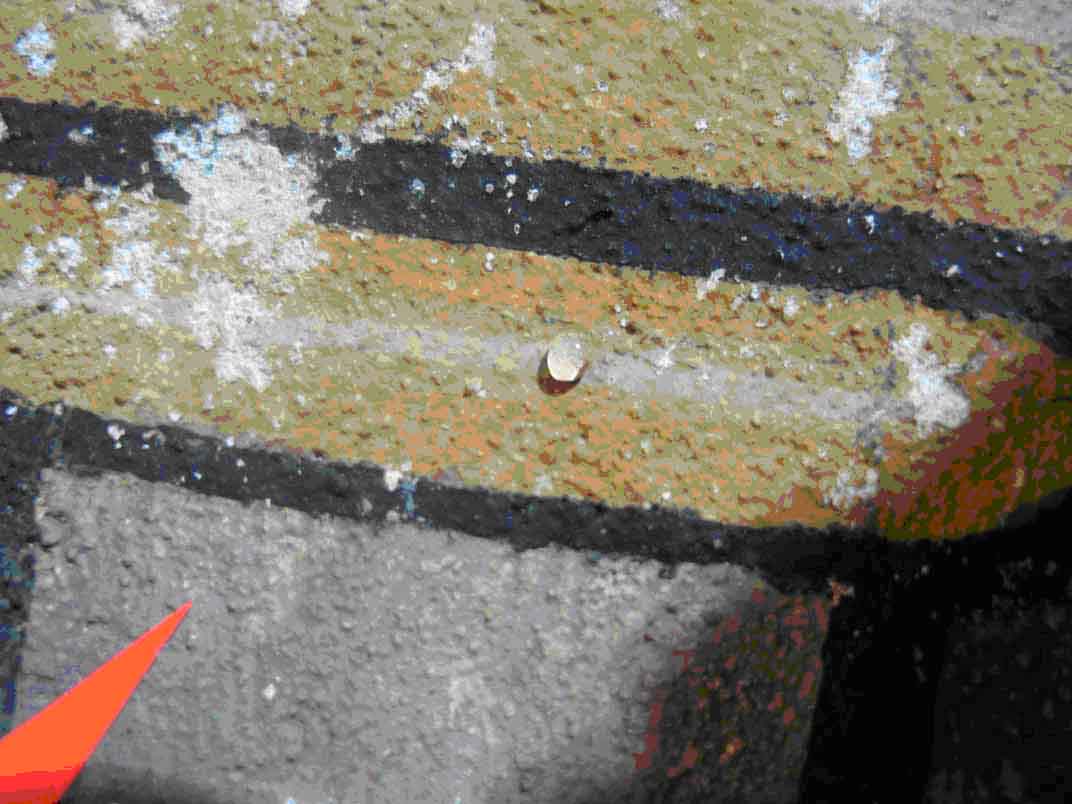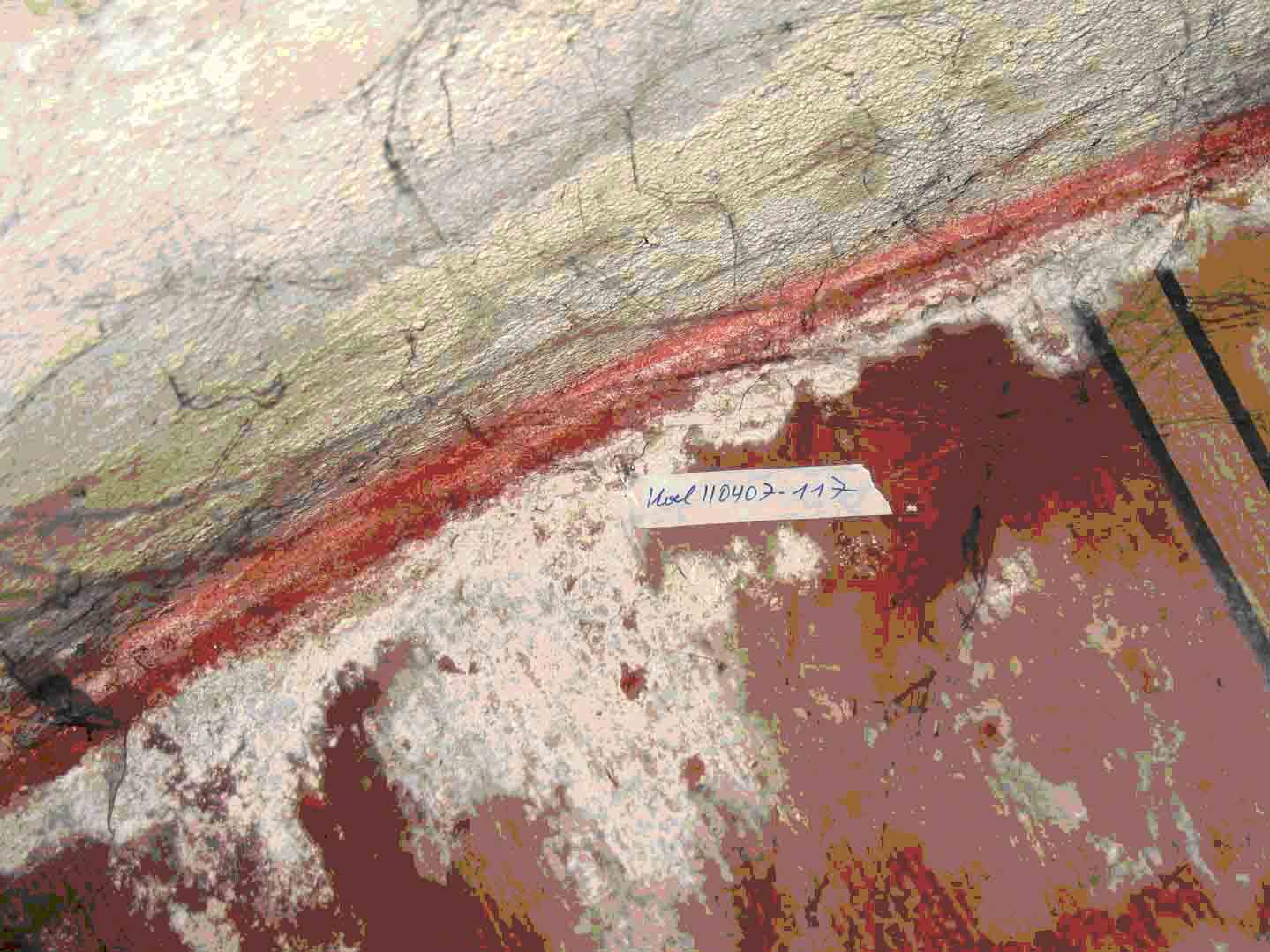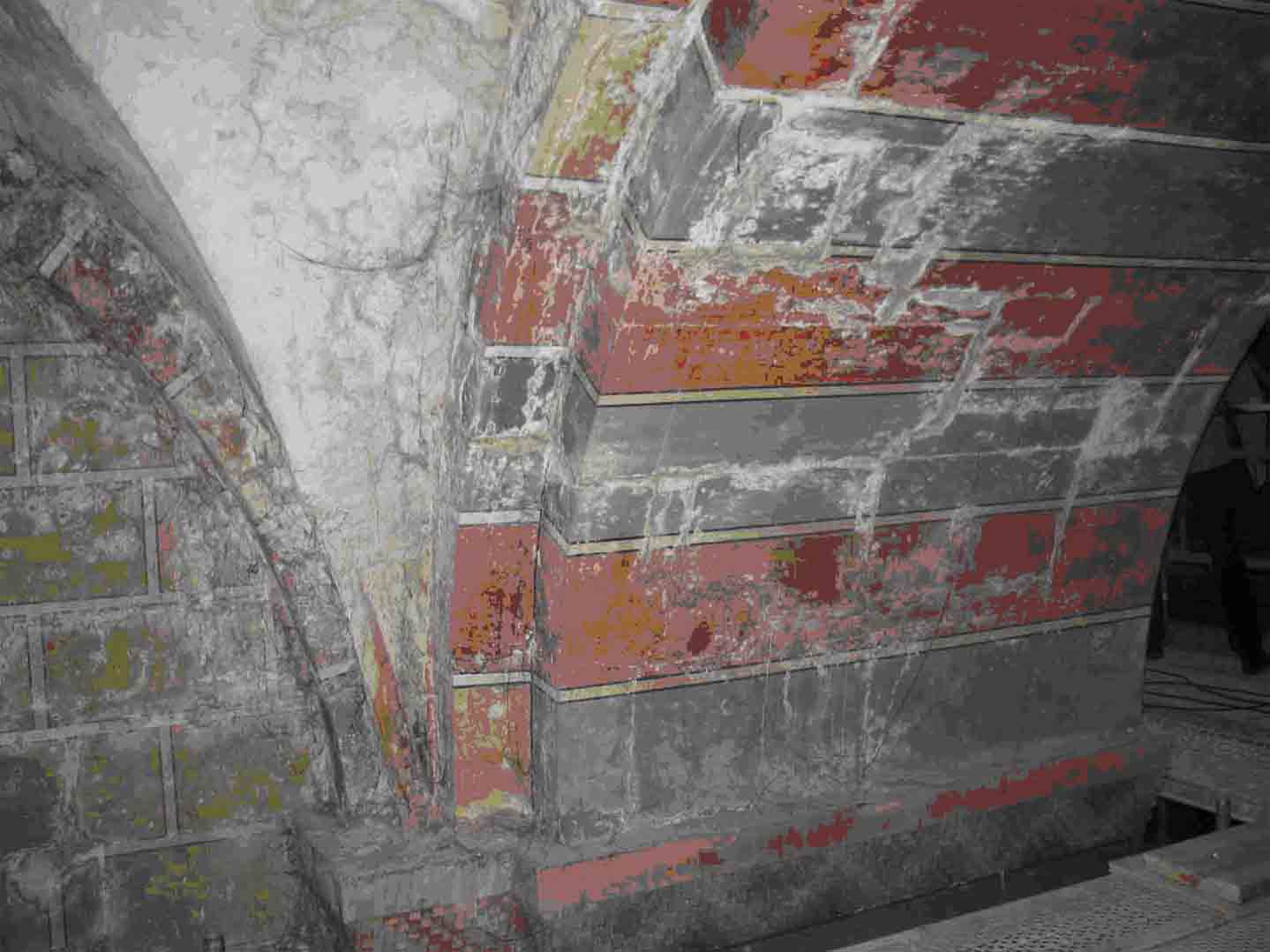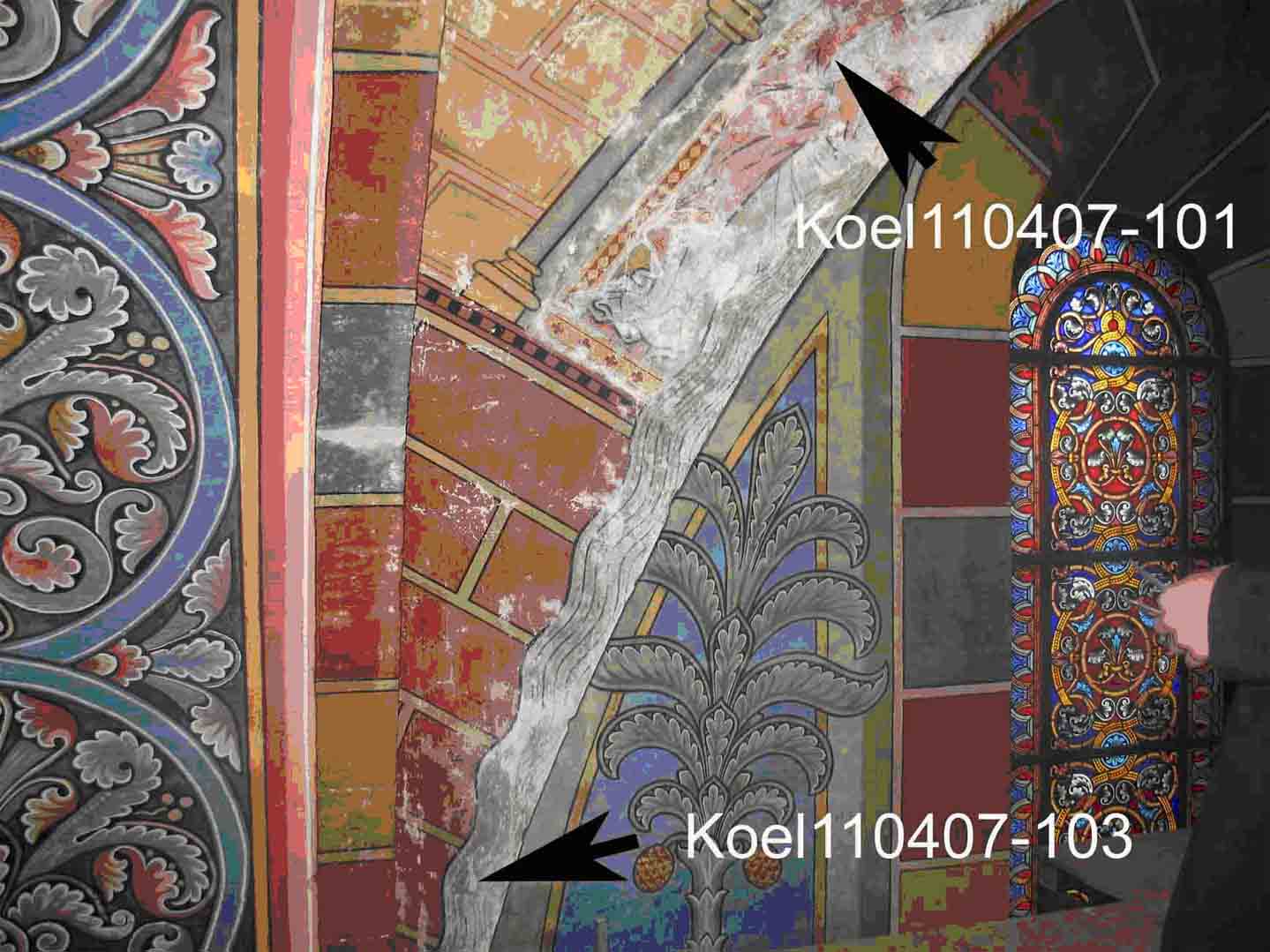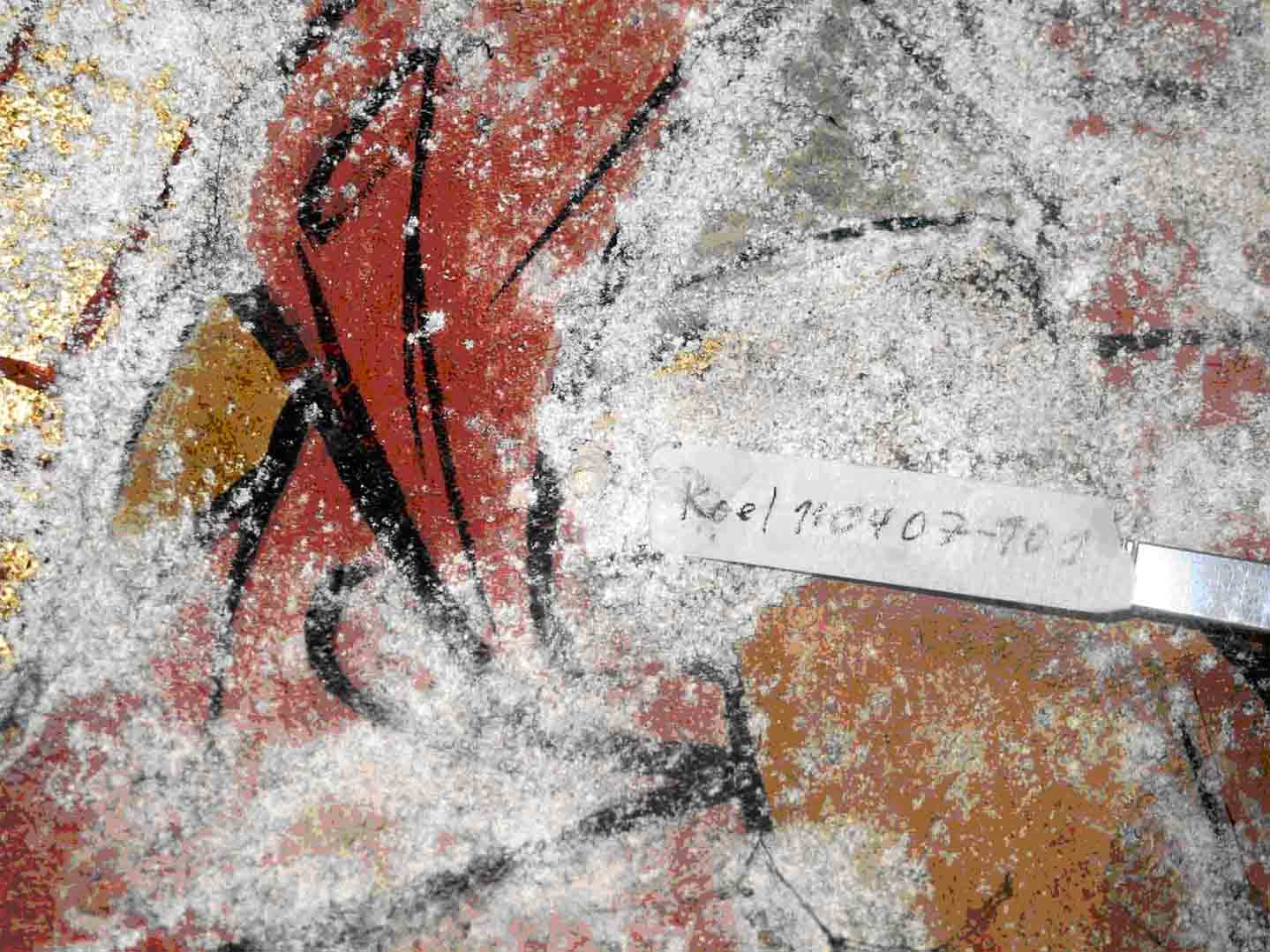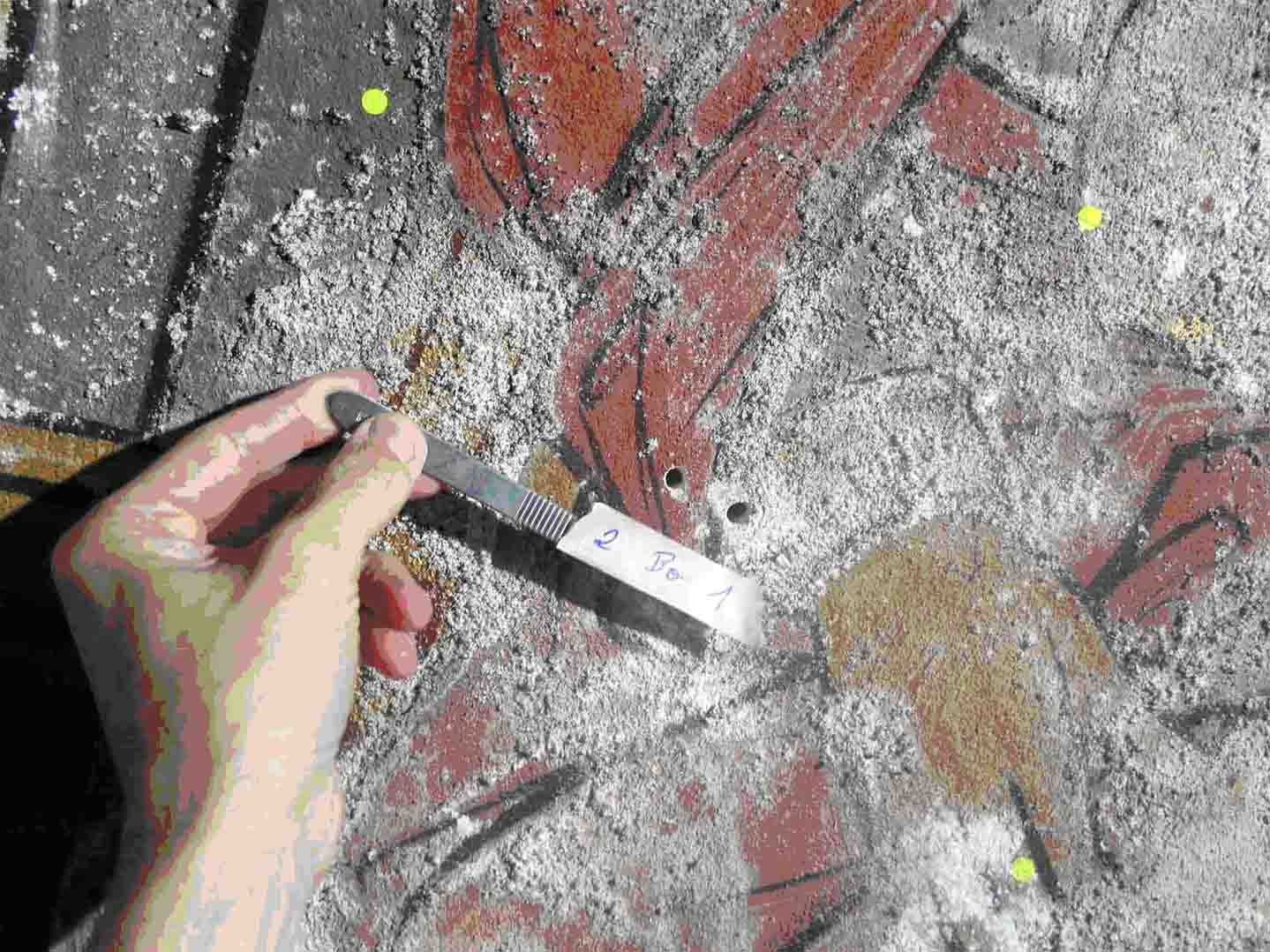Schwarz.etal 2008
Hans-Jürgen Schwarz 1, Erwin Stadlbauer2, Rolf Niemeyer 2
- Ri-Con/Research in Conservation, 30177 Hannover, Germany
- Niedersächsisches Landesamt für Denkmalpflege, D-30175 Hannover, Germany
Diagnostic investigations to define the possibility and the effectiveness of desalination with the poultice-technique - a case study.- In: Ottosen, LM. et al. (Eds.), Salt Weathering on Buildings and Stone Sculptures. Technical University of Denmark, Proceeding of the conference in Copenhagen 22-24 October 2008, pp. 237-248
Abstract
The contamination of the walls, especially the surfaces with salt and a salt solution is often one of the biggest problems concerning the conservation concept of wall paintings. A good example for that is the Cathedral in Königslutter in Northern Germany.
The wall paintings of the Cathedral in Königslutter go back to a medieval wall painting, which was painted over at the end of the 19th century. In the second half of the 20th century large amounts of cement suspension were injected into the walls to stabilize the static of the building, which started the damaging process essentially by salt crystallisation at the inner surfaces of the cathedral. After the outbuilding was completely repaired in 2006 the conservation of the wall paintings, plasters etc. in the cathedral begun.
The analyses of surface samples and the drill - sampling show a high salt content consisting of sulphate and calcium ions, nitrates (mostly together with potassium but also with calcium) and rarely chloride and sodium. Salt efflorescences are often made of gypsum partially together with Calcite as a sinter crust. Fluffy efflorescences consist of niter. The total amount of salt only in some cases decrease with the depth of sampling.
To extract the salts in the wall painting and in the plaster the poultice method was chosen. Before applying this method the surfaces have to comply with the requirements for a successful application e.g. the moisture transport characteristics. The results show clearly that the first plaster layer, which is slightly hydrophobic in some parts, very slowly transported moisture. Despite the low moisture transport rates the poultice method was tested, because salt action is the most damaging process. The application tests show that only a small amount of salt can be extracted.
Keywords:
Desalination, wall painting, Mirowski method, droplet method, poultice.
Volltext
Die vollständige Publikation finden sie unter Datei:SWBSS2008 Schwarzetal.pdf
Anlagen
Zitierte Literatur
Behrens, E., Berling, H., Hornschuh, A., Niemeyer, R., Recker, B., Schwarz, H.-J., Stadlbauer, E. (2005): Wandmalerei Referenzflächen-Monitoring am Beispiel der Stiftskirche Königslutter – Methoden und Erkenntnisse für die praktische Denkmalpflege. Berichte zur Niedersächsischen Denkmalpflege [1]; 9-12.
Price, C., (ed.) (2000): An expert chemical model for determining the environmental conditions needed to prevent salt damage in porous materials. European commission, Protection and Conservation of the European Cultural Heritage. Research report No 11. 136 p.
Grote, R.-J., van der Ploeg, K. (2001): Wandmalereien in Niedersachsen, Bremen und im Groningerland, Aufsatzband, Deutscher Kunstverlag, 502 p.
Königfeld, P. (1996): Die Raumausmalung. Der Kaiserdom in Königslutter. Ein Kulturdenkmal auf dem Prüfstand. Braunschweigischer Kloster- und Studienfonds & Institut für Denkmalpflege (eds.) 10 – 13
Niemeyer, R.; Stadlbauer, E. (1996): Die Wasserdampfdurchlässigkeit der Wandmalereioberflächen im Innenraum der Stiftskirche Königslutter. Der Kaiserdom in Königslutter. Ein Kulturdenkmal auf dem Prüfstand. Braunschweigischer Klosterund Studienfonds & Institut für Denkmalpflege, (eds.) 54 – 58
Rösch, H. (1996): Salz – und Feuchtebelastung. Der Kaiserdom in Königslutter. Ein Kulturdenkmal auf dem Prüfstand. Braunschweigischer Kloster- und Studienfonds & Institut für Denkmalpflege, (eds.) 59 – 63
WTA Merkblatt 3-13-01/D (2003): Non-destructive desalination of natural stones and other porous building materials with poultices,. Wissenschaftlich-Technische Arbeitsgemeinschaft für Bauwerkserhaltung und Denkmalpflege e.V. 13 p.
Primärdaten
Dünnschliffuntersuchungen
- Untersuchungen mit dem Polarisationsmikroskop
- KL-Oberputz mit Malschicht Gipskristalle Buk1,35mm.jpg
Oberputzmit der Malschicht. man erkennt deutlich die schädigenden Gipskristalle_: Bildunterkante = 1,35mm
Analyse der salzbildenden Ionen
Methode: Ionenchromatorgraphie -- LINK
| cm Tiefe | Sulfat | Nitrat | Chlorid | Natrium | Kalium | Magnesium | Calcium | Summe | |
| M% | M% | M% | M% | M% | M% | M%
| |||
| Bo NW re 0-1 cm | 1 | 0,0348 | 0,0102 | 0,0044 | 0,0034 | 0,0098 | 0,0028 | 0,036 | 0,1014
|
| Bo NW li 0-0,7 cm | 1 | 0,23 | 0,0122 | 0,0056 | 0,0024 | 0,0107 | 0,0032 | 0,104 | 0,3681
|
| Bo NW li 1-2 cm | 2 | 0,152 | 0,0313 | 0,0159 | 0,0095 | 0,0304 | 0,0029 | 0,164 | 0,406
|
| Bo NW li 2-3 cm | 3 | 0,0645 | 0,0135 | 0,0063 | 0,0093 | 0,0387 | 0,0025 | 0,0819 | 0,2167
|
| Bo NW li 3-5 cm | 5 | 0,0529 | 0,013 | 0,005 | 0,0074 | 0,0649 | 0,0076 | 0,143 | 0,2938
|
| Bo QH 0-1 cm | 1 | 0,217 | 0,308 | 0,0332 | 0,0116 | 0,0263 | 0,0156 | 0,149 | 0,7607
|
| Bo QH 1-2 cm | 2 | 0,134 | 0,573 | 0,0707 | 0,0287 | 0,0654 | 0,0206 | 0,169 | 1,0614
|
| Bo QH 2-3 cm | 3 | 0,0899 | 0,584 | 0,0642 | 0,0308 | 0,066 | 0,0153 | 0,16 | 1,0102
|
| Bo QH 3-5 cm | 5 | 0,89 | 0,4 | 0,0567 | 0,02 | 0,0445 | 0,0194 | 0,522 | 1,9526
|
| Mörtel | 0,444 | 0,838 | 0,166 | 0,286 | 0,254 | 0,738 | 2,726
| ||
| Kompresse | 0,0708 | 0,0609 | 0,0301 | 0,0165 | 0,0074 | 0,0091 | 0,0498 | 0,2446
| |
| Kompresse | 0,0665 | 0,353 | 0,0394 | 0,0253 | 0,0111 | 0,0188 | 0,145 | 0,6591
|
| M% | BO | Tiefe | Sulfat | Nitrat | Chlorid | Natrium | Kalium | Magnesium | Calcium | Summe | LF | Einwaage |
| cm | M% | M% | M% | M% | M% | M% | M% | M% | [µS/cm] | mg | ||
| Koel-110407-01 | 1 | 1: 0 - 1 | 0,732 | 0,025 | 0,008 | 0,003 | 0,016 | 0,01 | 0,335 | 1,13 | 402,1 | |
| Koel-110407-02 | 1 | 1: 1 - 3 | 0,249 | 84 | 506,6 | |||||||
| Koel-110407-03 | 1 | 1: 3 - 6,5 | 0,055 | 0,008 | 0,003 | 0,002 | 0,016 | 0,002 | 0,052 | 0,1361 | 504,8 | |
| Koel-110407-04 | 2 | 2: 0 - 1,5 | 0,123 | 0,015 | 0,005 | 0,002 | 0,008 | 0,002 | 0,083 | 0,2388 | 493,4 | |
| Koel-110407-05 | 2 | 2: 1,5 - 3 | 1,139 | 331 | 496,6 | |||||||
| Koel-110407-06 | 2 | 2:3 - 5 | 0,402 | 0,005 | 0,002 | 0,012 | 0,004 | 0,239 | 0,6631 | 289,7 | ||
| Koel-110407-07 | 3 | 2:0 - 1 | 0,384 | 0,03 | 0,006 | 0,008 | 0,007 | 0,003 | 0,214 | 0,6522 | 436,6 | |
| Koel-110407-08 | 3 | 3:1 - 3 | 0,453 | 140 | 496,6 | |||||||
| Koel-110407-09 | 3 | 3:3 - 5,5 | 0,296 | 0,019 | 0,003 | 0,006 | 0,006 | 0,002 | 0,161 | 0,4925 | 500,1 | |
| Koel-110407-10 | 4 | 4:0 - 1 | 0,077 | 0,493 | 0,028 | 0,012 | 0,259 | 0,002 | 0,239 | 1,1104 | 329,7 | |
| Koel-110407-11 | 4 | 4:1 - 2 | 0,515 | 1,24 | 0,14 | 0,074 | 0,344 | 0,008 | 0,634 | 2,9554 | 154 | |
| Koel-110407-12 | 4 | 4:2 - 5 | 4,983 | 165 | 54,1 | |||||||
| Koel-110407-13 | 5 | 5:0 - 1 | 0,366 | 0,368 | 0,048 | 0,013 | 0,025 | 0,008 | 0,299 | 1,1265 | 444 | |
| Koel-110407-14 | 5 | 5:1 - 3 | 1,715 | 389 | 390,4 | |||||||
| Koel-110407-15 | 5 | 5:3 - 5,5 | 0,165 | 0,522 | 0,092 | 0,019 | 0,034 | 0,009 | 0,299 | 1,1388 | 343,6 | |
| Koel-110407-16 | 6 | 6:1 - 3 | 9,153 | 2310 | 468,8 | |||||||
| Koel-110407-17 | 7 | 7:0 - 1 | 3,086 | 490 | 275,9 | |||||||
| Koel-110407-18 | 8 | 8:0 - 1 | 7,51 | 0,6 | 0,045 | 0,03 | 0,056 | 0,032 | 3,34 | 11,6123 | 217,2 | |
| Koel-110407-19 | 8 | 8:1 - 2,5 | 1,304 | 397 | 524,6 | |||||||
| Koel-110407-20 | 8 | 8:2,5 - 5 | 0,174 | 0,03 | 0,016 | 0,006 | 0,008 | 0,003 | 0,11 | 0,3475 | 473,1 | |
| Koel-110407-21 | 9 | 9:0 - 1 | 0,384 | 0,731 | 0,123 | 0,288 | 0,2 | 0,38 | 2,106 | 405,8 | ||
| Koel-110407-22 | 9 | 9:1 - 4 | 6,185 | 752 | 214,6 |
Kapillare Feuchteaufnahme
- Wasseraufnahme mit der Tröpfchenmethode
- KL FT-1.jpg
Feuchetaufnahme mit der Tröpfchenmethode
Schadensfotos - Probennahme
- Dokumentation der Probenentnahme
- Koel-110407-102.jpg
Probenstelle Koel-110407-102
